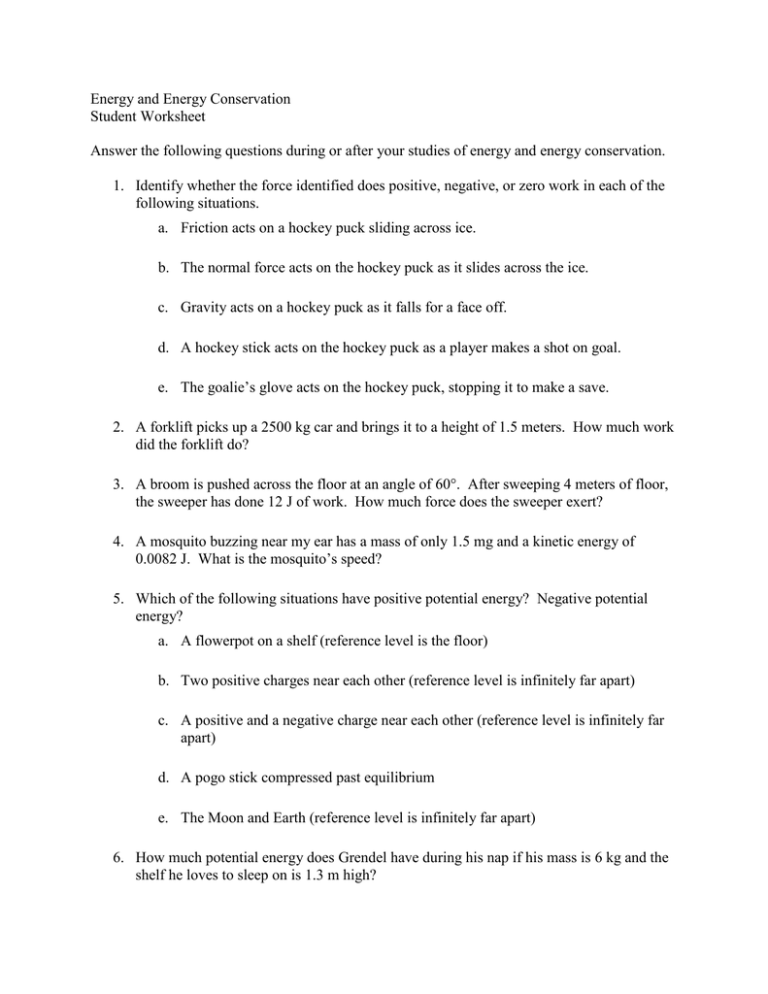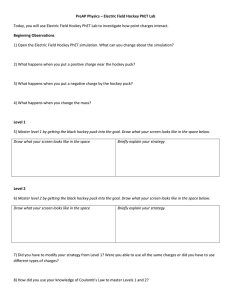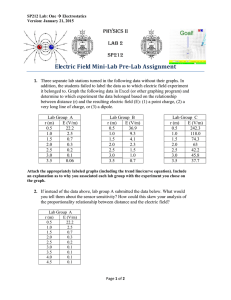Energy and Energy Conservation Student Worksheet
advertisement

Energy and Energy Conservation Student Worksheet Answer the following questions during or after your studies of energy and energy conservation. 1. Identify whether the force identified does positive, negative, or zero work in each of the following situations. a. Friction acts on a hockey puck sliding across ice. b. The normal force acts on the hockey puck as it slides across the ice. c. Gravity acts on a hockey puck as it falls for a face off. d. A hockey stick acts on the hockey puck as a player makes a shot on goal. e. The goalie’s glove acts on the hockey puck, stopping it to make a save. 2. A forklift picks up a 2500 kg car and brings it to a height of 1.5 meters. How much work did the forklift do? 3. A broom is pushed across the floor at an angle of 60°. After sweeping 4 meters of floor, the sweeper has done 12 J of work. How much force does the sweeper exert? 4. A mosquito buzzing near my ear has a mass of only 1.5 mg and a kinetic energy of 0.0082 J. What is the mosquito’s speed? 5. Which of the following situations have positive potential energy? Negative potential energy? a. A flowerpot on a shelf (reference level is the floor) b. Two positive charges near each other (reference level is infinitely far apart) c. A positive and a negative charge near each other (reference level is infinitely far apart) d. A pogo stick compressed past equilibrium e. The Moon and Earth (reference level is infinitely far apart) 6. How much potential energy does Grendel have during his nap if his mass is 6 kg and the shelf he loves to sleep on is 1.3 m high? 7. A particular bungee cord is designed so that it can contain 750 J of potential energy when it is stretched 8 m past its equilibrium position. What is the spring constant (k) for this bungee cord? 8. What is the potential energy of a 50 kg satellite in orbit around the earth (Mass = 6.0 x 1024 kg, radius = 6.4 x 106 m) at a height above the surface of 300 km? 9. What happens to the potential energy of the satellite above if it is moved closer to the surface of Earth? Further from the surface? Explain. 10. What is the potential energy of an electron (q = -e = -1.6 x 10-19 C) in orbit at a distance of 1 x 10-10 m around a proton (q = +e) in a hydrogen atom? What would happen to the potential energy if the electron got closer to the proton? Further away? Explain. 11. How do stars produce energy from fusion? Explain in terms of nuclear binding energy. 12. How do nuclear power plants produce energy from fission? Explain in terms of nuclear binding energy. 13. A roller coaster starts at rest at the top of a hill 15.0 meters above the ground. How fast is the roller coaster going when it is 4.0 m above the ground? 14. A bullet with mass 0.350 kg is travelling at 285 m/s when it enters a chamber containing 2.00 kg of water at room temperature (300.0 K). Assuming the bullet comes to rest by the end of the chamber, what temperature will the water be? 15. An electron in hydrogen emits a photon with frequency 4.571 x 1014 Hz. Did the electron gain or lose energy? How much? Did it move closer or further from the nucleus? 16. Infrared thermometers work by measuring the peak wavelength of your blackbody radiation and inferring your temperature. If you are running a fever, how does your peak wavelength compare to that from when you are well? 17. How much energy does the ozone molecule gain or lose when it emits its 11.072545 GHz photon? Energy and Energy Conservation Teacher Notes This worksheet is intended to accompany the Energy and Energy Conservation PowerPoint (Energy and Energy Conservation.pptx) created as part of Haystack Observatory’s RET project on Physics and MOSAIC. The PowerPoint can be used as an in-class presentation, but also could be re-envisioned as a Webquest-type activity of self-directed learning. This worksheet is intended to give students practice solving problems and thinking conceptually about energy and energy conservation. The PowerPoint associated with it does not include any worked examples, so some teachers may want to supplement their lesson by working some of these examples in class, using a textbook or other resource to supplement for student practice. 1. Identify whether the force identified does positive, negative, or zero work in each of the following situations. a. Friction acts on a hockey puck sliding across ice. Negative; Friction almost always does negative work, since it is in the opposite direction of motion. b. The normal force acts on the hockey puck as it slides across the ice. Zero; the normal force is (by definition) perpendicular to the motion, so there is no work done. c. Gravity acts on a hockey puck as it falls for a face off. Positive; gravity pulls down, and the puck falls down. They are in the same direction, so positive work. d. A hockey stick acts on the hockey puck as a player makes a shot on goal. Positive; again, the stick pushes forward and the puck moves forward: same direction, so positive work. e. The goalie’s glove acts on the hockey puck, stopping it to make a save. Negative; the glove pushes forward on the puck (the only direction it can push), while the puck displaces it slightly in the direction it was moving. Also, the glove slows down the puck, which provides another hint that the work is negative. 2. A forklift picks up a 2500 kg car and brings it to a height of 1.5 meters. How much work did the forklift do? Work = Force * distance = (2500) (9.8) (1.5) = 37,000 J 3. A broom is pushed across the floor at an angle of 60°. After sweeping 4 meters of floor, the sweeper has done 12 J of work. How much force does the sweeper exert? Work = F d cos θ = 12 J = F (4 m) (cos 60); F = 12 / (4 * 0.5) = 6 N 4. A mosquito buzzing near my ear has a mass of only 1.5 mg and a kinetic energy of 0.0082 J. What is the mosquito’s speed? KE = ½ m v2 = 0.0082 J = ½ (1.5 x 10-3) v2; v2 = 2 * 0.0082 / 0.0015; v =3.3 m/s 5. Which of the following situations have positive potential energy? Negative potential energy? a. A flowerpot on a shelf (reference level is the floor) Positive potential energy. Work had to be done to bring the flowerpot from the floor to the shelf. b. Two positive charges near each other (reference level is infinitely far apart) Positive potential energy. Work had to be done to bring the charges together from infinitely far apart. c. A positive and a negative charge near each other (reference level is infinitely far apart) Negative potential energy. Work would have to be done to bring them back to the reference level. This is a bound system. d. A pogo stick compressed past equilibrium Positive potential energy. Work had to be done to compress the spring. e. The Moon and Earth (reference level is infinitely far apart) Negative potential energy. This is a bound system, and work would have to be done to separate the masses. 6. How much potential energy does Grendel have during his nap if his mass is 6 kg and the shelf he loves to sleep on is 1.3 m high? PEg = mgh = 6 kg* 9.8 m/s2 * 1.3 m = 76 J 7. A particular bungee cord is designed so that it can contain 750 J of potential energy when it is stretched 8 m past its equilibrium position. What is the spring constant (k) for this bungee cord? PE = ½ k x2 = 750 J = ½ k (8 m)2; k = (2 * 750 J) / 64 m2 = 23.4 N/m 8. What is the potential energy of a 50 kg satellite in orbit around the earth (Mass = 6.0 x 1024 kg, radius = 6.4 x 106 m) at a height above the surface of 300 km? PE = –GMm/r = -(6.67 x 10-11 Nm/kg2)(5.98 x 1024 kg)(50 kg) / (6.4 x 106 + 300 x 103) = –3.0 x 109 J 9. What happens to the potential energy of the satellite above if it is moved closer to the surface of Earth? Further from the surface? Explain. The potential energy decreases if the satellite gets closer to the surface, becoming more negative. This is more favorable position in terms of energy; the satellite “wants” to be as close to the Earth as possible. It is attracted to the Earth, so the minimum energy occurs when they are close together. If the satellite moves further away, the potential energy will decrease, becoming closer to zero (it is only zero when they are infinitely far apart, because of our conventional decision about reference level). This is because, again, the satellite and Earth are attracted, and bringing them further apart adds potential energy to the system. If they are released, they will come closer together, releasing KE and potentially doing work. 10. What is the potential energy of an electron (q = -e = -1.6 x 10-19 C) in orbit at a distance of 1 x 10-10 m around a proton (q = +e) in a hydrogen atom? What would happen to the potential energy if the electron got closer to the proton? Further away? Explain. PE = kQq/r = (9.0 x 109 N m / C2) –(1.60 x 10-19 C)2 / 1 x 10-10 m = –2.3 x 10-18 J The potential energy would decrease (become more negative) if the electron got closer, since the electron and nucleus attract each other, and the minimum energy must occur when they are in their most favorable position, or as close together as possible. If the electron moved further away, the PE would increase, becoming closer to zero. It would only equal zero when the electron and nucleus were infinitely far apart (our reference level). This is because work would need to be done to separate the charges, thus adding potential energy to the system in bringing them further apart. 11. How do stars produce energy from fusion? Explain in terms of nuclear binding energy. Stars release energy from fusion by taking small nuclei (with very small binding energy) and combining them into larger nuclei (with larger binding energy). The larger nucleus is more stable than the smaller nucleus, thus releasing the difference in (potential energy) binding energy of the nuclei is released into the surrounding of the star’s center, powering the star. 12. How do nuclear power plants produce energy from fission? Explain in terms of nuclear binding energy. Nuclear power plants break down very large nuclei (larger than iron, with small binding energy) into smaller nuclei (with larger binding energy). The smaller nuclei are more stable than the very large nuclei, and the difference in nuclear potential energy (binding energy) is released as energy to the reactor. 13. A roller coaster starts at rest at the top of a hill 15.0 meters above the ground. How fast is the roller coaster going when it is 4.0 m above the ground? Friction is negligible, and all energy sources seem to be mechanical, so I can conserve mechanical energy: Ei = Ef, the energy is a combination of PE and KE PEi + KEi = PEf + KEf, but KEi = 0 gives PEi = PEf + KEf, substituting for PE and KE gives mghi = mghf + ½mv2, masses cancel, so (9.8 m/s2)(15 m) = (9.8 m/s2)(4 m) + ½ (v2); v = 14.7 m/s 14. A bullet with mass 0.350 kg is travelling at 285 m/s when it enters a chamber containing 2.00 kg of water at room temperature (300.0 K). Assuming the bullet comes to rest by the end of the chamber, what temperature will the water be? The energy of the bullet that is lost as it comes to rest is transferred as heat to the water, causing its temperature to rise. That is, Ei - Ef = mC∆T ½ mv2 – 0 = mC(Tf – Ti) ½ (0.350)(285)2 = (2.0 kg)(4186 J/K kg)(Tf – 300 K) 14200 = 8370 (T – 300.0 K) T = 301.7 K 15. An electron in hydrogen emits a photon with frequency 4.571 x 1014 Hz. Did the electron gain or lose energy? How much? Did it move closer or further from the nucleus? The electron lost energy, since it is releasing energy in the form of a photon. In order to have lost potential energy, it must have moved closer to the nucleus. ∆E = hf = 6.626 x 10-34 Js (4.571 Hz) = 3.029 x 10-19 J 16. Infrared thermometers work by measuring the peak wavelength of your blackbody radiation and inferring your temperature. If you are running a fever, how does your peak wavelength compare to that from when you are well? The higher the temperature, the higher the peak frequency emitted and the shorter the peak wavelength. So, if you have a fever, your peak wavelength is shorter than if you were well. 17. How much energy does the ozone molecule gain or lose when it emits its 11.072545 GHz photon? The molecule must lose rotational energy, since it is emitting a photon, and the energy for that photon must have come from the energy lost by the molecule. ∆E = hf = 6.626 x 10-34 Js (11.072545 GHz) = 7.337 x 10-4 J







